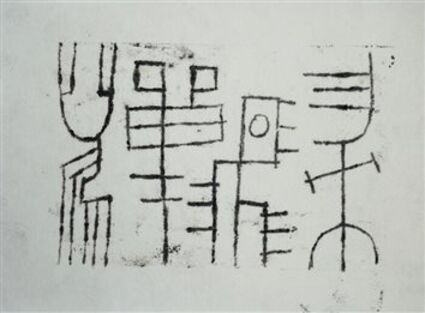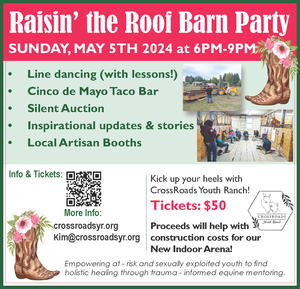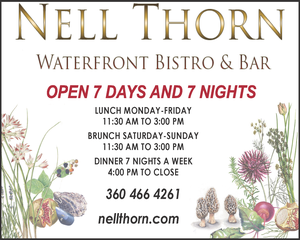Artists taking on new mediums in natural study
At i.e. in Edison through April 25
April 21, 2021

"No Soliciting," James Brems, no date, oil transfer drawing, 11 x 18". i.e. gallery. Photo courtesy of Margy Lavelle
Some Northwest artists have recently learned fairly new techniques to express the changing forms in nature. That means sculptors were painting, painters were sculpting and other new techniques were at work to express Earth’s ancient patterns. The results are on display at the latest art show at Edison’s i.e. Gallery through April 25.
Allen Moe, Michael Clough and James Brems have all taken on a new – or relatively new – medium for their latest work. Sculptor Moe is displaying a series of oil drop paintings. Clough, traditionally a painter, has completed a collection of carved stones while James Brems – painter and wood carver -- is distilling his work to the simplicity of transfer drawings.
For more than a year Margy Lavelle, i.e. Gallery owner, has been planning the exhibit, sparked by a visit to Michael Clough’s studio in Anacortes. She was surprised to see rock sculptures there. “I was blow away by them,” she said. “His work was astounding, and he had never worked with that medium. This was a big surprise.” Clough was using carving to study the transitory nature of the environment over millennia, through the lines and shapes of rock.
Lavelle then spoke with two more artists undertaking their own new approach to their art that seemed to harken back to the long, patient nature of evolution. Allen Moe, who – like Clough – lives off the grid on the Skagit River, has built a body of work and reputation as a ceramicist. Moe was also experimenting in a new medium: paint. Seattle artist James Brems, in the meantime, was reinventing his own work, due to a flooded basement that had damaged his previous work and studio. So Brems was starting again by creating transfer drawings – many in the spirit of petroglyph drawings of more ancient times.
Clough and Moe showed their work together 30 years ago in the Edison Eye, the same site as that of the i.e. Gallery today.
Some exhibits seem to bring themselves together without heavy-handed planning, Lavelle says, and that was the case with this one.
Clough’s rock carvings began about two years ago. He had found rocks that were ancient tools carved by human hands – probably for use by indigenous fishermen and hunters. He found himself watching for signs of carved stone on beaches, “and I thought they were beautiful, I thought it’s not just a piece of stone they picked up and pounded, they probably carried it with them,” he says, they may have been prized possessions.
So Clough started carving rocks too, with a focus on art: to coax out a natural shape within, not to make something new but to bring out the natural shapes of the rock and its history. Clough does not work with power tools or heavy equipment like chisels. So for his project he used sandpaper and files. When standard files could not penetrate the hardest rock he moved to a diamond file. His sculptures explore the innate lines of the stone. “I following patterns in the rock and they take shape,” he says.
Clough is attracted the ancient history of the stones. Their shapes result from tumbling down rivers, into the ocean, smashing around on beaches, grounding down to sand, in some cases being pressed into new stone. As a carver he spent time sitting and staring at the rock before him for hours. For Clough, his time alone with each rock is a story of natural history. “It’s gotten me interested in geology,” he says.
Brems made his own change in medium out of necessity. The Seattle artist is known for large carvings, simple shapes and color. When his body of work was damaged in a flooded basement, he found a new way for artistic expression by using oil transfer drawings on mulberry paper. It challenged him, according to his artist’s statement, with the unpredictability of oil on the line thickness and weight. As it settled into the paper, the oil made detours that he says led to both interesting and unpredictable results. His work speaks of another time in human history, with petroglyph style imagery.
Moe, long known for his clay and other ceramics work, has turned to oil paint. But he is never confined by tradition, and he found his own way to apply paint, letting nature help guide the work.
Like Clough, Moe was exploring forces of the environment by dropping a high volume of oil paint, watching it coagulate and move as it dried.
The drying process is long – as much as a year – and like Clough, Moe relied on patience to let nature takes its course.
Moe’s work may seem like a departure from the typically muted Northwest paintings, because of the intensity of the color, Lavelle says.
He uses primary colors, and has been mixing in new colors reminiscent of places where he’s been – from Rounding the Bend at Bald Mountain, to Burning Orchard from the mines in the Sonoran Desert in Arizona.
“He’s selecting colors tied to places or memories,” Lavelle said and they appear as if they were shapes seen under a microscope.
“Allen is such a biologist.
He’s interested in the principles of physics and how that underlies everything,” and that has found its way into his work no matter the medium, Lavelle explained.
“He lets nature decide what happens.”












Reader Comments(0)